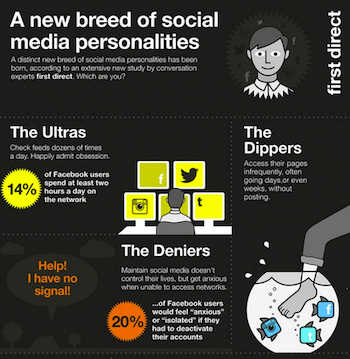first direct combines pubic relations and social media for its Social Study
Social Study social media and PR campaign strives to uncover how people are using social networks and what behaviour happens as a result
 Campaign name
Campaign name: The first direct Social Study
Company: first direct
Audience: Social media-savvy professionals (aged 25-34), along with social media influencers and commentators
Duration: 10/04/2013 to 03/05/2013
Budget: Under £25K
Channels: Off / online PR and social media
Social Media Portal (SMP): Agencies behind the campaign?Aberfield PR (APR):
Aberfield PR and
@aberfieldprSMP: The full name of the brand (company it is for)?APR:
first direct and
@first_direct SMP: What is the official campaign name and why was it chosen?APR
SMP: What is the official campaign name and why was it chosen?APR: The first direct Social Study. We chose it because, as the saying goes, it does what it says on the tin!
SMP: What was the start and end of the campaign?APR: It was launched on 10/04/2013 and ended on 03/05/2013
SMP: Who are the target audiences of the campaign, who are you trying to reach and why?APR: We targeted social media-savvy professionals, aged 25-34, along with social media influencers and commentators. The former audience are key customers for first direct, while the latter help to position the brand as experts in customer engagement, both online and offline.
SMP: Briefly, tell us about your campaignAPR: How first direct engages with customers in social media is becoming increasingly important, so understanding how those customers use social networks is crucial if that engagement is to be effective.
We set up a month-long experiment with 40 volunteers who were asked to change their Facebook and Twitter habits, and we monitored how it affected their conversations and relationships with friends and family.
We also conducted a nationwide survey to get a broader insight into social media attitudes and behaviours, and used this information to develop a set of personality types in social media.
SMP: What were the goals of the campaign and why was it different? APR: Our goal was simply to get people talking about how they and others behave in social media. At no point did we mention any first direct products, or even drive people to the first direct website. We put the information out there so that people could talk about it, and share it, via their own social networks.
There are lots of social media surveys and reports out there, but this campaign was different because no one had done a study in this way before.
SMP: How did you source the data to create the social study?APR: The qualitative data was sourced via the month-long experiment with 40 volunteers, who were recruited specifically and who were demographically representative of the UK population. Their activities were monitored on a daily basis and each had to maintain detailed diaries of their changing attitudes to social media.
The quantitative data came from a representative survey of 1,500 adults across the UK, who were quizzed on their use of social media, and their attitudes towards those platforms.
The data was analysed by Dr David Giles, a reader in media psychology at Winchester University and an expert in social media behaviours. Dr. Giles provided a summary of his conclusions for the report.
SMP: What were the channels, platforms and methods you used?APR: We used only
PR (online and offline) and social media for this campaign. In order to provide additional content that could be shared online, we created a video and infographic to support the campaign.
SMP: What did you achieve and what have you learnt from these results?
APR replies with:
? Offline coverage in more than 25 national and regional newspapers
? 340+ websites and blogs covered at least one element of the study (including Mail Online, Telegraph, Express etc)
? Infographic carried on 100+ websites and blogs
? Directly reached more than 12.5 million people (excluding tweets & re-tweets)
? More than 2,900 shares in social media (excluding infographic) directly from websites and blogs
? Infographic shared directly more than 2,700 times
? More than 1,200 tweets and re-tweets about the study
We learnt that people?s experiences of social media are largely dependent on the number of offline friends they have who are using the same social network. Social media ?newbies? tend to enjoy the experience if they can easily find people to communicate with, whereas for those who struggle to make meaningful contacts it feels like shouting in an empty room. It can also make people feel socially isolated and ?unwanted?.
We also learnt that people can display
different personalities depending on the extent of their social media activity and on the frequency and type of content they create on the networks. Those personalities can often be very different to their ?real world? personalities.
SMP: What is the budget used for the campaign?APR: Can?t be specific, but less than £25,000.
SMP: How did you make the campaign social?APR: Making the campaign social was absolutely key, which was why we created shareable content, such as the full study report, the typologies (via an infographic) and the video. By targeting social media websites and blogs, we also encouraged comment about the study and for people to share the content via Facebook, Twitter, Google+ and LinkedIn.
SMP: Why was there the decision to create the infographic and how long did it take to design?APR: The infographic had a dual purpose: to bring the typologies to life and to provide shareable content.
SMP: Are there any plans to repeat or build upon the campaign? If yes, how? If not, why not?APR: first direct will use the study results to influence its future customer engagement strategies in social media, but this particular campaign isn?t one that could be repeated (we would probably get the same answers!).
Got a good campaign you'd like to tell us about and share? Tell us at SMP contact.
